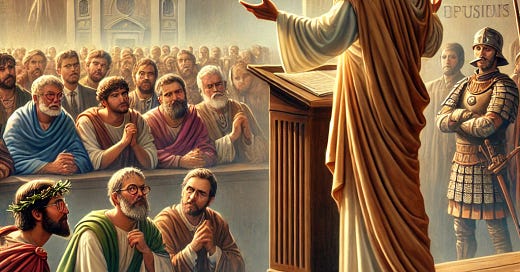The text excerpts analyze the leadership strategies employed by Jesus Christ, framing them as effective power tactics within a social and political context. The author examines Jesus's methods for building an organization, gaining followers, and confronting the established authorities.
Specific examples of Jesus's actions and teachings are cited and analyzed to illustrate these power tactics. The analysis draws parallels between Jesus's approach and other historical figures known for their effective leadership strategies.
Ultimately, the text posits that Jesus’s success stemmed from his shrewd understanding and masterful manipulation of power dynamics.
Based on the provided source, here are the key elements of Jesus' organizational model:
Recruitment from the Lower Strata:
Jesus did not recruit from the establishment but from the lower strata of the population.
Demanding Commitment:
He asked those he recruited to give up everything related to ambition in society and to abandon all other commitments, including family ties.
He is quoted as saying, "He that loveth father or mother more than me is not worthy of me: and he that loveth son or daughter more than me is not worthy of me".
Creation of an Elite Group:
Jesus created a group of twelve disciples, and is also reported to have had seventy others in his organization.
He gave these men the status of an elite, and required them to follow him, giving up all other loyalties.
He promised them that they would achieve power and not just learn from him as a teacher.
Training:
Jesus trained his cadre, and he managed them. He did not want his followers to surpass him and he put them in their place by criticizing them. He emphasized their inability to do miracles and heal properly, and their jealousy over whoever was first with him and highest in rank when success came.
Emphasis on Unity and Persecution:
Jesus used the persecution by outsiders as a tactic for bringing unity to his group.
He told his followers that they would be scorned and persecuted.
Promise of Power:
Jesus promised his followers power and that they would achieve their goals. He also said that he came to set a man at variance against his father, and the daughter against her mother.
Structured Organization:
The organizational tactics of Jesus are presented as a structured method for achieving power, where Jesus was the leader and his disciples were to be completely devoted to him and his movement. They were required to give up ambition and loyalty to other groups.
Defined Roles:
The disciples were to be "fishers of men," and were to be completely devoted to the leader and his movement.
Offering Incentives:
In exchange for their sacrifices, Jesus offered his disciples status within the organization and the promise of power in the kingdom.
Emphasis on Service:
He defined the leader's movement as having the purpose of saving mankind, which made it difficult to resist, but he also defined the leader as someone who does not seek personal power.
Hierarchical Structure:
By defining the leader as an interpreter of the great force which he serves, and by only giving a select few insight into his teachings, Jesus created a hierarchical structure, where the leader is at the top.
By structuring his organization this way, Jesus was able to establish a movement that ultimately exerted great influence.















Share this post